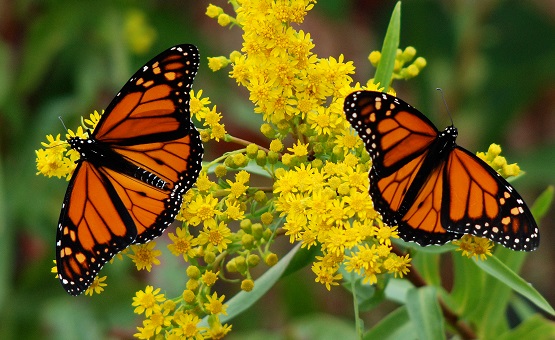The State We're In
A bold plan: Save 30 percent of America’s land and oceans for nature
In his 2016 book, book “Half Earth: Our Planet’s Fight for Life,” biologist and author Edward O. Wilson made a strong case for preserving half the planet – both land and oceans – for nature. This, he argued, is the best way to prevent a mass extinction of species that could lead to the collapse of humanity.
The nature-saving idea was energized in 2018 when Swiss philanthropist Hansjörg Wyss donated a billion dollars to launch the Wyss Campaign for Nature, aimed at achieving 30 percent conservation by 2030. Later that year, several large conservation groups added their voices, calling for 30 percent of the planet to be protected by 2030 and 50 percent to be protected by 2050.
With a new President committed to tackling the climate crisis, the United States is now on the same path to preserving a significant percentage of our land and oceans.
President Biden last week signed executive orders pledging to conserve at least 30 percent of the nation’s land and coastal waters by 2030, less than a decade from now.
The “30 by 30” vision was announced a week after the President kicked off his climate agenda by rejoining the Paris Agreement to limit global warming, and launching a review of the previous administration’s rollbacks of environmental protections for air, water and land.
The Biden administration’s plan to conserve at least 30 percent of U.S. lands and oceans by 2030 is ambitious but critical if we are to save the planet’s diversity of species and buffer against the worst impacts of climate change by protecting ecosystems that absorb and store carbon. It comes at a time when the U.S. is losing the equivalent of two football fields of natural land every minute, or about 1.5 million acres a year, according to a study by the nonprofit Center for American Progress.
According to the Center for American Progress, only about 12 percent of the country’s land has been conserved as national parks, wilderness areas, permanent conservation easements, state parks, national wildlife refuges, national monuments, and other protected areas.
The Center for American Progress found that 26 percent of U.S. controlled oceans are safeguarded from the most intense extractive uses such as drilling for oil and gas – but most of these protected waters are in the remote western Pacific Ocean or northwestern Hawaii. There are no U.S. waters in the Gulf of Mexico, the mid-Atlantic, or the North Pacific that are highly or fully protected.
What about New Jersey?
The Garden State has been a national leader in land preservation for decades and has already met the 30 percent target. This state we’re in covers about 5 million acres, of which about a third are preserved, a third are either developed or planned for development, and a third are up for grabs.
With a sound base of preserved lands already secured, New Jersey can get to work on reaching the 50 percent advocated by E.O. Wilson and others.
Since the early 1960s, New Jerseyans have enthusiastically voted to support every land preservation ballot question. And in 2014, New Jersey adopted a permanent and sustainable source of land preservation funding from a portion of the Corporate Business Tax.
By continuing to preserve lands that support wildlife habitat and biodiversity, and absorb harmful carbon emissions from the atmosphere, New Jersey will continue to lead the nation.
And by conserving 30×30, the United States will re-establish itself as a leader in conserving nature, leveraging nature to address climate change and making more outdoor spaces available to all Americans.
The path to conserving 30 percent nationally, and 50 percent in New Jersey, will require partnerships and coordination between government agencies, private landowners and community-based nonprofit organizations known as land trusts. And it’s imperative that conservation projects embrace an inclusive and equitable vision that reflects the values of all Americans, including urban residents and communities of color.
Clean air and water, a stable climate, abundant food supplies, a diversity of plant and animal life, a strong economy and a habitable planet are essential. These bold plans are huge steps in the right direction.
To learn more about President Biden’s climate agenda, go to www.whitehouse.gov/briefing-room/statements-releases/2021/01/27/fact-sheet-president-biden-takes-executive-actions-to-tackle-the-climate-crisis-at-home-and-abroad-create-jobs-and-restore-scientific-integrity-across-federal-government/.
To learn more about E.O. Wilson’s Half Earth project, go to https://eowilsonfoundation.org/.
To read the Center for American Progress report on saving 30 percent of the nation’s land by 2030, and 50 percent by 2050, go to https://www.americanprogress.org/issues/green/reports/2019/08/06/473242/much-nature-america-keep/.
And for information on preserving New Jersey’s land and natural resources, visit the New Jersey Conservation Foundation website at www.njconservation.org or contact me at info@njconservation.org.
About the Authors
Alison Mitchell
Co-Executive Director
John S. Watson, Jr.
Co-Executive Director
Tom Gilbert
Co-Executive Director, 2022-2023
Michele S. Byers
Executive Director, 1999-2021
View their full bios here.
Filter
Get The Latest News
From The Garden State
In the
News

